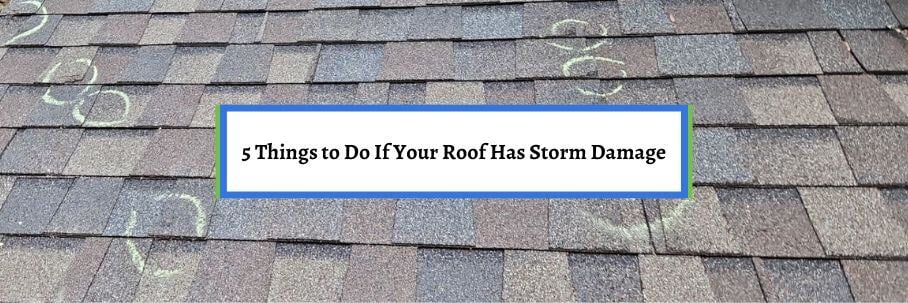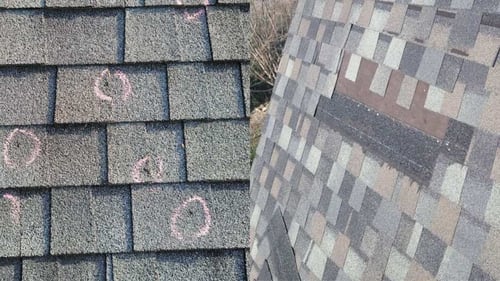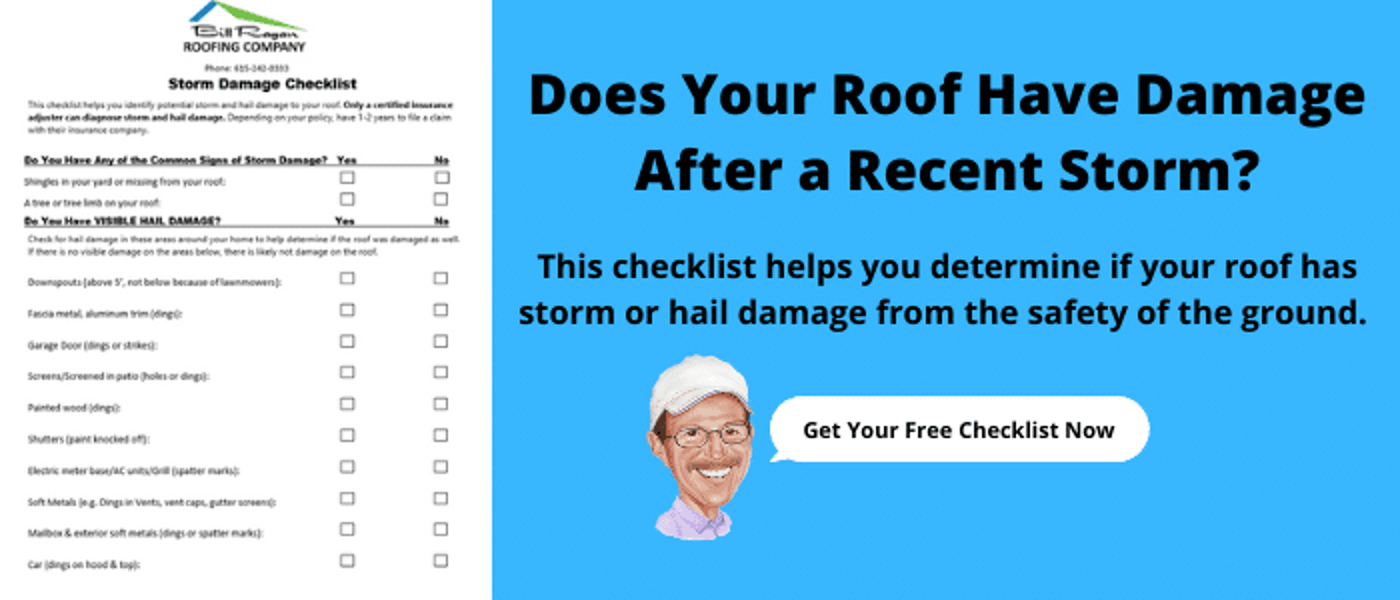5 Things to Do If Your Roof Has Storm Damage

Was your roof damaged in a recent storm? Are you trying to figure out what to do?
The most important advice I can give in this situation is not to panic. Unless you have a hole in your roof, most storm damage won’t lead to an immediate leak.
However, you’ll still need to determine if it’s covered, if there’s a viable claim, and if going forward is worth it.
For over 30 years, Bill Ragan Roofing has taken pride in guiding homeowners through the insurance claim process. Now, I’ll put this experience to use to help you get started.
First, we’ll get into the 5 things you need to do if your roof has storm damage. After that, I break down what happens after your claim is actually approved.
1. Make sure roof damage is covered in your insurance policy
Most homeowners insurance policies cover roof damage caused by extreme weather or a storm event. For roofing, this includes damages caused by straight-line winds (aka damaging winds), hail, and fallen trees/limbs.

So, first, you need to learn what roof damage is covered under your policy. As long as there aren’t exclusions, most insurance policies will pay for roof damage caused by wind or hail.
However, you still need to ensure what is and isn’t covered before going any further.
2. Check if you have an ACV or RCV policy
When checking for what’s covered, you also need to check the policy type to learn if you have Actual Cash Value (ACV) or Replacement Cost Value (RCV) coverage. Both policies provide a payout from the insurance company, but the amount is very different.
An Actual Cash Value policy only provides the depreciated value of your roof. This means you’ll only get a payout for what your roof is valued at the time of the claim to put towards the overall cost.
On the other hand, a Replacement Cost Value policy pays out what it costs to replace your entire roof with a brand new version of itself. However, getting the full cost of a new quality roof system covered is rare without putting in some work (more on this in a bit).
3. Consider your deductible
No matter what a roofer says or what you hear, YOU must pay your deductible once your insurance claim is approved. So, you need to keep this in mind when filing a claim because you’ll end up paying it in the end.
Let’s see it in action for both an ACV and RCV policy for a roof replacement costing $15,000 and a $1,000 deductible.

Just remember that deductibles greatly vary, so you must also consider how a higher deductible affects the amount you’ll end up paying. However, this is up to every individual homeowner to decide based on their policy.
4. Reach out to your insurance company
After checking your policy and deciding to move forward, I recommend contacting your insurance company to ensure you follow their exact steps. They’ll get all the relevant information, walk you through their process, and send out an adjuster or tell you to contact a roofer first.
Who comes first doesn’t matter because the adjuster and roofer will perform their own inspections. However, having a trusted roofer handy for the adjuster appointment is a good idea.
That way you have someone in your corner and to keep the adjuster honest during their inspection.
5. Get a storm damage roof inspection from a trusted roofer
Now, all that’s left to do is to get a storm damage roof inspection. Even though this step comes after contacting insurance here, getting an inspection from a roofer to feel 100% confident about moving forward is common.
Most cases require an inspection from an adjuster, even if a roofer has already done theirs. Whoever is there first will perform a full roof inspection and mark roof areas with missing shingles, granule loss, hail marks, dents in metal, and any other damage with chalk.

After marking roof damage, they’ll take pictures of everything and determine if there’s a viable claim. Just keep in mind that most adjusters aren’t professional roofers, which is why you should have your roofer there.
What happens after your roof damage claim is approved?
After the inspections, it’s all about the waiting game to learn if your claim is approved or denied. If you get a denial, you need to decide if you want to pursue options available to challenge it.
However, what happens after getting approved depends on the policy. Let’s look at the process after approval for both policies.
What happens with an ACV policy?
An ACV policy only provides one check for the depreciated value of your roof once the claim is approved. You’ll get a quote from a roofer, use the actual cash value payout (minus your deductible), make up the price difference out-of-pocket, and get your roof replaced.
Keep in mind that the payment is yours to use as you wish after paying your deductible. However, this could leave your home vulnerable, and future claims for the same area will be denied if you fail to take care of it after filing.
What happens with an RCV policy?
Once an RCV policy is approved, another process begins. Below is a breakdown of what happens once your roof damage claim with an RCV policy is approved.
Supplement anything missing from the insurance estimate
Once approved, your insurance company provides an estimate for the scope of work to replace your roof. The initial estimate usually won’t cover the full cost because certain line items and important things businesses need to be covered (mainly overhead and profit) are left off.
This is where you’ll need to supplement your claim by taking the roofer’s estimate, comparing the difference in line items, making the appropriate changes, and submitting it to your insurance company for approval. It’s rare to get approval without hassle, and there’s usually some back-and-forth before coming to an agreement where everyone is satisfied.
But if you’re happy with the payout and don’t want to deal with supplementing, just pay your deductible plus the difference in the estimates.
Get your roof replaced per the scope of work
Once the estimate is finalized, you’ll first get a check for the Actual Cash Value from the insurance company. This will cover the initial deposit, and the roofer will schedule your roof replacement.
After that, your roof will be replaced per the insurance claim following the scope of work. If anything is missing or you didn’t supplement, your roofer will also work off their own estimate to ensure you get a quality roof up to local codes.
Get the final check from the insurance company
After your roof is replaced, you still need to get the final check to cover what’s left after the ACV check. To get it, your roofer will take photo documentation and submit it to the insurance company to prove it was done per the claim.
Once they determine it matches the scope of work, you’ll get a second check (minus your deductible) with the recoverable depreciation to put towards what’s left to pay. You'll keep the second check if you have already paid the full amount out of pocket.
If you didn’t, you must sign over the recoverable depreciation check to cover what’s still owed to your roofer. Once that’s done, your roof replacement through insurance is complete.
How do you find a reputable roofer for a roof damage insurance claim?
After reading this article, you know the 5 things you need to do if your roof has storm damage and what happens after getting approved. Every insurance company does things differently, but most of the information here is a pretty standard process.
Just know this process can be long and tedious, so you need a trusted roofer to guide you. Unfortunately, insurance work also brings out the worst in the roofing industry.
So, you need to know how to spot a reputable roofer you can count on to do things the right way. That’s why I wrote another article with tips for finding a reputable roofer specifically for insurance claims.
Check out 7 Tips When Hiring a Roofing Company for an Insurance Claim to ensure you find a great one in your area to take care of your damaged roof.


